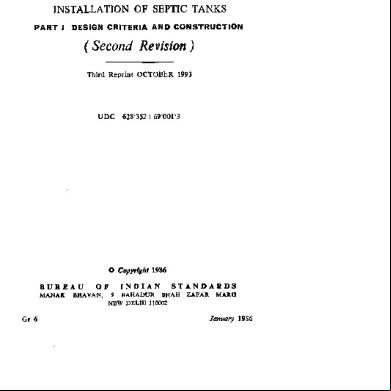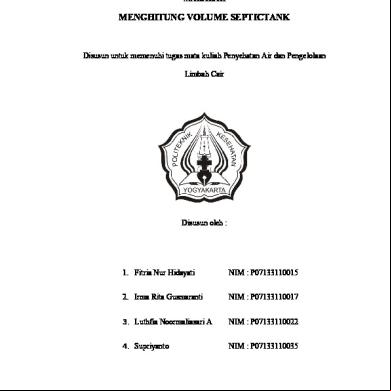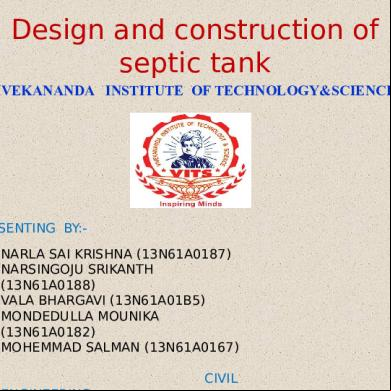Septic Tank Design Computation 141kq
This document was ed by and they confirmed that they have the permission to share it. If you are author or own the copyright of this book, please report to us by using this report form. Report 3b7i
Overview 3e4r5l
& View Septic Tank Design Computation as PDF for free.
More details w3441
- Words: 377
- Pages: 4
SEPTIC TANK DESIGN
DEFINITION OF Septic Tank – a water-tight receptacle which receives the discharge of a sanitary plumbing system or part thereof, designed and constructed to retain solids, digest organic matter through a period of detention and to allow the liquids to discharge into the soil outside of the tank through a system of open-ted sub-surface pipings or a seepage pit meeting the requirements of the code. Sewage – any wastewater containing animal or vegetable matter in suspension or solution and may include liquids containing chemicals in solution. Scum – Material floating on the surface of the septic tank. Scum usually contains fats, oils and greases. Sludge – the “sinkable” solids (soil, grit, bones, unconsumed food particles) settle to the bottom of the tank and form a sludge layer. Effluent – the clarified wastewater leftover after the scum has floated to the top and the sludge has settled to the bottom. It flows through the septic tank outlet into the drain field. Daily sewage flow – the volume in gallons of sewage and liquid wastes flowing into a septic tank during a 24 hours period. Manhole – Access opening to a hole, usually with a cover, through which a person may enter a sewer. Cleanout – drain pipe that provides access for the purpose of clearing an obstruction. PVC – Polyvinyl Chloride. Potable water pipings are color-coded BLUE.
COMPUTATION FOR THE SIZE OF THE SEPTIC TANK
Type of Establishment: No. of Persons: Gallons per person per day: Gallons per day:
Single family dwelling 9 75 9 x 75 = 675
Using the formula: V = 1.125 + 0.75Q where
V = Liquid volume of the tank in gallons Q = The daily sewage flow in gallons per day. 1.125 and 0.75 are constant values.
V = 1.125 + 0.75 (675) V = 507.375 gallons V = 507.375 gallons (
)
V = 1.92 m3 For the dimensions of the septic tank, the minimum depth is 1.20 meters and the width is assumed to be 1.0 meter: Length of the digestion chamber:
=
L=
= 1.60 meters
Total Length: +L=
+ 1.6 = 2.40 meters
References: Revised National Plumbing Code of the Philippines, Chapter 2 Plumbing Design & Estimate by Max Fajardo, Jr., pp. 92-96 http://www.standardplumbing.com
DEFINITION OF Septic Tank – a water-tight receptacle which receives the discharge of a sanitary plumbing system or part thereof, designed and constructed to retain solids, digest organic matter through a period of detention and to allow the liquids to discharge into the soil outside of the tank through a system of open-ted sub-surface pipings or a seepage pit meeting the requirements of the code. Sewage – any wastewater containing animal or vegetable matter in suspension or solution and may include liquids containing chemicals in solution. Scum – Material floating on the surface of the septic tank. Scum usually contains fats, oils and greases. Sludge – the “sinkable” solids (soil, grit, bones, unconsumed food particles) settle to the bottom of the tank and form a sludge layer. Effluent – the clarified wastewater leftover after the scum has floated to the top and the sludge has settled to the bottom. It flows through the septic tank outlet into the drain field. Daily sewage flow – the volume in gallons of sewage and liquid wastes flowing into a septic tank during a 24 hours period. Manhole – Access opening to a hole, usually with a cover, through which a person may enter a sewer. Cleanout – drain pipe that provides access for the purpose of clearing an obstruction. PVC – Polyvinyl Chloride. Potable water pipings are color-coded BLUE.
COMPUTATION FOR THE SIZE OF THE SEPTIC TANK
Type of Establishment: No. of Persons: Gallons per person per day: Gallons per day:
Single family dwelling 9 75 9 x 75 = 675
Using the formula: V = 1.125 + 0.75Q where
V = Liquid volume of the tank in gallons Q = The daily sewage flow in gallons per day. 1.125 and 0.75 are constant values.
V = 1.125 + 0.75 (675) V = 507.375 gallons V = 507.375 gallons (
)
V = 1.92 m3 For the dimensions of the septic tank, the minimum depth is 1.20 meters and the width is assumed to be 1.0 meter: Length of the digestion chamber:
=
L=
= 1.60 meters
Total Length: +L=
+ 1.6 = 2.40 meters
References: Revised National Plumbing Code of the Philippines, Chapter 2 Plumbing Design & Estimate by Max Fajardo, Jr., pp. 92-96 http://www.standardplumbing.com





